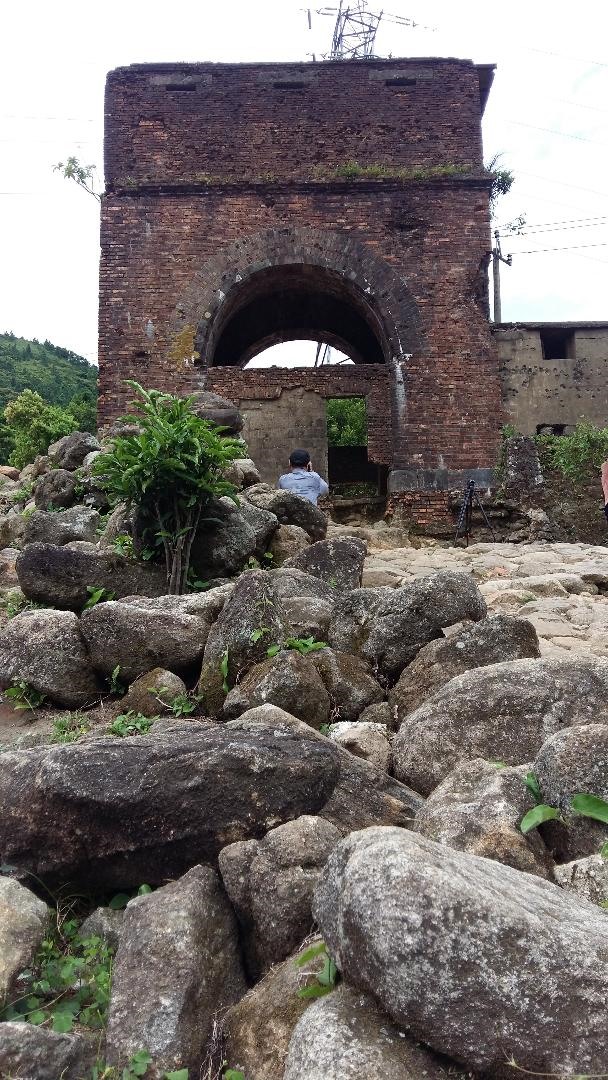 Life & Style
Life & Style

An excavation on the Hải Vân Gate complex on the 490m above sea level Hải Vân Pass has unveiled a clear layout of the old foundations of citadel walls and a section of the north-south route dating back to 1470.
 |
| An overall view of the Hải Vân Gate complex at the top of the Hải Vân Pass. An excavation on the site unveiled the locations the 1470-built relic on the border of Thừa Thiên-Huế province and Đà Nẵng city. — VNS Photo Công Thành |
ĐÀ NẴNG — An excavation on the Hải Vân Gate complex on the 490m above sea level Hải Vân Pass has unveiled a clear layout of the old foundations of citadel walls and a section of the north-south route dating back to 1470.
Archaeologists from the National Historical Museum and the Huế Monuments Conservation Centre revealed the information at a press conference on the initial excavation on the site.
The Hải Vân Gate, situated on the border of Thừa Thiên-Huế and Đà Nẵng city, had been in ruins for years due to weather. It was recognised as a National relic in 2017 after a 20-year dispute on the boundary of Thừa Thiên-Huế and Đà Nẵng.
The excavation, which was begun on 900sq.m in May, clearly identified the base level foundations of 1826-built two gates – at north and south – which were either changed of structure or damaged during the war (1946-1975).
Researchers also unearthed the original boundary of the Hải Vân Gate relic, which was overlapped by 1960s-built rock walls and tunnels built by the French and the US soldiers during the French and the American wars.
“It’s an important discovery to mark the original location of the old relic before restoration. Part of the structure of the relic was changed during the war when the French and the US troops built bunkers at the site,” director of the Huế Monuments Conservation Centre, Phan Thanh Hải, said at the briefing.
Hải said some new brick and rock walls, concrete roofs and steel ladders were also built as an accommodation unit for the barracks.
Archaeologist Nguyễn Ngọc Chất said locations of damaged items were unveiled after a three-month excavation.
“We have identified that a citadel was built to connect the north gate (on the Thừa Thiên Huế Province area) and the south gate (on Đà Nẵng border). The citadel was completely damaged, but only the rock foundation of the citadel was unearthed after the excavation,” Chất said.
“An old entrance (on Đà Nẵng side) was also exposed from the digging, while locations of a warehouse and house for mandarin of the gate were also found. We also marked the original positions of five cannons on the citadel for defence,” he said.
Chất said fragments of ceramic tools, stainless steel and glass objects were found at the site.
He said two stone steles were unearthed at the site, but only one was carved with name in the Han (Chinese) scripts.
Chất said the restoration of the relic will be completed in 2020.
Vice chairman of Thừa Thiên-Huế Nguyễn Dung said he highly appreciated the unique architecture and design of the old relic including the old citadel, the two gates and centuries built north-south route from the Nguyễn Dynasty.
He said the site will be a favourite destination for both visitors from Đà Nẵng and Huế cites in exploring history and long existence of the unique architecture.
Hải Vân Pass, 28km away from Đà Nẵng and 80km far from Huế city, is the only road allowing tankers or road adventurers to travel between Đà Nẵng and Huế since the Hải Vân tunnel became operational in 2005.
The Hải Vân Gate hosted 320,000 tourists in 2017. — VNS
Inbox:
The Hải Vân Gate, situated at the top of Hải Vân Pass, is a complex of brick-built gates from the 19th century, and octagonal bunkers from the French colonial period.
According to researchers, 95 per cent of the site was in Thừa Thiên-Huế, while only a part of the old wall and a victory monument of the Đồn Nhất (First Garrison) during the French War were fully within the Đà Nẵng border.
Since the Nguyễn Dynasty, the sight has seen two resistance wars against the French and the Americans. It was also once the border between Đại Việt (the Great Việt, now Việt Nam) and the Champa Kingdom, which ruled the region between the fourth and 13th centuries.
Historically, Hải Vân Pass belonged to the Hindu Champa Kingdom under Jaya Simhavarman III (1288-1307), but the two provinces of Ô (now Quang Tri) and Lý ( now Thừa Thiên-Huế) were given in exchange for the marriage of Huyền Trân Princess, daughter of King Trần Anh Tông. Hải Vân Pass then became the border between Đại Việt and the Champa Kingdom.
The two brick gates were reinforced with concrete and steel-bar roofs in the fight against Vietnamese guerillas (French colonial period) in 1826, and then during the American war.
In 1470, King Trần Nhân Tông named the Hải Vân Gate ‘the most marvellous wonder’. The inscriptions on the gate arches have survived. — VNS
 |
| South Gate of the Hải Vân Gate relic on the border of Đà Nẵng city. — VNS Photo Công Thành |
 |
| North Gate of the Hải Vân Gate relic on the Thừa Thiên-Huế province side. Archaeologists plan to restore the relic as it was built from previous centuries. — VNS Photo Công Thành |
 |
| A brick built foundation was unearthed on the Hải Vân Gate relic on the top the 490m above sea level Hải Vân Passs. — VNS Photo Công Thành |




